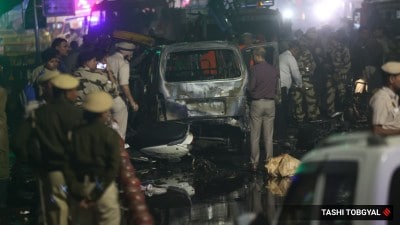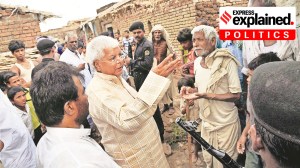‘They can’t change, just can’t stop killing’
Those who hoped that the murder of Paritala Ravi, dreaded don and TDP MLA of Anantapur, may bring the curtains down on the bloody saga of Ra...

Those who hoped that the murder of Paritala Ravi, dreaded don and TDP MLA of Anantapur, may bring the curtains down on the bloody saga of Rayalaseema need to think again.
For, Ravi was just one of the hundreds of hard men who have ruthlessly dominated life and times in this region. And their tribe has been at it for the last 400 years.
‘‘Nothing can stop them. They are an extension of the state’s arm now,’’ says Dr S Seshaiah, general secretary, Andhra Pradesh Civil Liberties Committee (APCLC).
These ‘‘factionist’’ mafia dons effectively rule much of the Rayalaseema districts of Anantapur, Cuddapah, Kurnool and neighbouring Bellary in Karnataka. And almost all of them have private armies, ready to kill and die for their leaders: from rigging and winning elections, bagging or controlling government contracts, grabbing land or mines, extortions and business disputes.
And then some more: appointing village watchmen, the right to beat drums in a village festival, grazing of cattle, fishing rights or procuring a village woman or two.
Unsolved murders pile into thousands in the region’s police stations. In many villages, these dons are the final arbiters of life and death. Consider these extracts from case studies in a police journal circulated to senior police officers here:
• Some years ago, the late Budha Vengal Reddy, Congress MLA and warlord of Atmakur, was speeding along a narrow ghat road, when a truck in front slowed them down, without giving way. After a km or so, the car overtook the bus and pulled up in front before the MLA got out and abused the truck driver.
The driver, who didn’t know Reddy, shouted back. The MLA reached inside his car, took out a rifle and shot the man dead. Then, believe it or not, Reddy dropped in at a police station and complained about the truck driver’s misbehaviour.
Of course, the police registered a case many days later, after newspapers got to know, and made an arrest too—not Reddy or his car driver.
• The son of Bijjam Satyanarayana Reddy, TDP MLA of Owk and factionist warlord, reached out of his jeep and shot at an Andhra Pradesh State Road Transport Corporation bus that couldn’t give him way. A woman in the bus was hit. Police decided it was an ‘‘accident’’.
• MLA Budha Vengal Reddy, like almost all Rayalaseema MLAs, monopolised control over the arrack and liquor trade in his constituency, including the temple town of Srisailam. But the head priest of the Brahmaramba temple in Srisailam, Gangadhar Achary, objected to liquor sales near his temple, and went to the police. The MLA reached the local Government Guest House and summoned the Achary, who begged Reddy’s men to wait until he finished the puja.
Reddy, of course, wasn’t used to waiting. He stormed into the temple with his men and dragged the priest out to the road, punching and kicking him. As worshippers, shopkeepers and passers-by watched, Reddy beat up the priest with his shoes.
The priest went again to the police, but Reddy walked free. Opposition MLAs made a noise in the Assembly, and the government ordered an enquiry. Nothing, of course, came out of it. No witness wanted to depose.
The factionist leaders come in many shapes, from village toughs and the archetypal feudal types to MLAs, MPs and ministers, but most of them belong to either of the two castes—Reddys and Kammas. Even Backward Caste factionists are not rare.
Their private armies number anywhere from 25 to over a few hundred men. Their work tools range from hunting sickles and battle axes to countrymade guns and bombs, and sophisticated foreign weaponry. Clashes and killings are all in a day’s work.
‘‘I have 72 factionist villages in this district, and at least eight of the region’s prominent faction lords operate from here. Fortunately, there were only 169 killings in my area last year—it used to be well over 200 earlier,’’ says Praveen Kumar, SP of Anantapur.
‘‘They kill for the silliest of reasons. There are now too many villages that don’t know how to cope with the orphans and widows that these feuds leave,’’ he adds.
Once born, factions and feuds get passed down many generations, even if for the most trivial of reasons.
Over a decade ago, when two villagers had an argument at a pan shop in Revanur, no one ever imagined what this would lead to. One went to landlord Chinna Narasimha Reddy for help, the other to his cousin Sivarami Reddy. The cousins took up their causes, and had the villagers in two warring groups behind them. Bombs and guns were soon out, and many men lay dead.
Two years of bloody battles later, Sivarami Reddy agreed to police requests to stop killing and surrender his arms. He went on a tractor to the local police station with his men and handed over their weapons. On their way back, his cousin’s men ambushed them with bombs, killed seven and cut Reddy to pieces. Then they hacked his head off and carried the trophy all over the village.
Now consider Thalamanchipatnam, in Cuddappah. Police records say a landowning villager there found a long strand of hair on his plate which he assumed was his neighbour’s wife’s—his own wife had short hair. He then started a slanging match with the neighbour, who immediately got some men on his side. Soon, there were two groups, sickles and axes were out and men lay dead.
This is how this small village got a full-fledged police station of its own. The cops say it continues to stand divided behind the two factions now. Only, these are headed by sons of the two original landlord-neighbours.
But the stakes could be a lot bigger too.
‘‘Till the 1970s, factions were mostly born of individual rivalries and feudal whims. From the 1980s, factionists learned to consolidate their strength into political power. By the 1990s, the politico-business mafia with a centralised chain of command took over. So the petty local warlords have become part of an elaborate command structure. That helps the state-level factionist bosses get their diktats done at the smallest village or taluka,’’ according to APCLC.
‘‘The factionists thrive by two means, used judiciously: feudal charity and complete domination. Like any other mafia, they don’t leave options to the people,’’ says Dr Seshaiah.
So much so that almost all of Rayalaseema’s MPs and MLAs now lead one faction or the other. That includes Chief Minister Y S Rajasekhara Reddy, from Cuddappah, whose father was a prominent factionist shot dead by a rival. Reddy himself had escaped bullets at the state secretariat.
In the big league of factionism, the fights are for multi-crore stakes or political domination—usually both. Tenders and contracts are decided by the political factionist MP or MLA in these districts.
Even the killings are getting sophisticated. ‘‘They are getting more clinical. They now do a lot of reconnoitering, take care of logistics, have lawyers ready, observe the police set-up, and ensure minimum risk to their hitmen now. Paritala Ravi’s killers, for instance, had been reconnoitering the area for over a month before killing him,’’ says a police officer.
‘‘Many faction warlords have massive investments in the country’s metros. Some of them run their extortion rackets and preserve their territory by remote control. Several hobnob with and can call some of India’s leading politicians by their first names,’’says a senior police officer.
A majority of Rayalaseema’s public offices remain reserved by both TDP and Congress for their own individual factionists, and even the successors and substitutes are fixed.
There is still no clear answer as to why so many choose to kill and die so easily in parts like Anantapur. Some say the drought and resultant poverty might be driving thousands to take to mindless violence. Anantapur, for instance, has the lowest rainfall in the country after Jaisalmer. Officially, some 437 farmers here had killed themselves unable to pay back debts, in the last six years.
‘‘But there are districts like Adilabad where people are equally poor. They don’t go around killing. These people here just can’t change, this is too ingrained in them. They can’t stop killing,’’ says Praveen Kumar, the Anantpur SP.



- 01
- 02
- 03
- 04
- 05



























